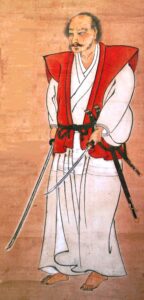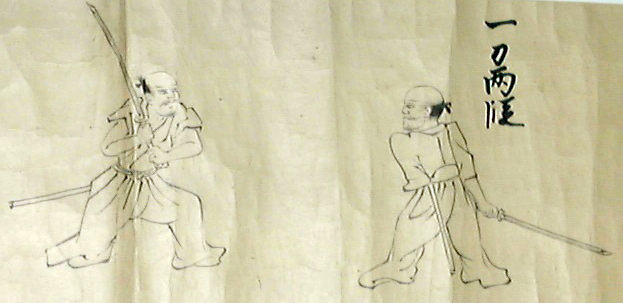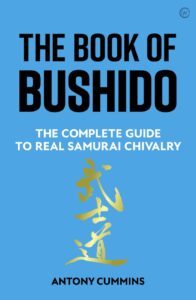The Path of Musashi By Antony Cummins
 I am attempting to walk the same path as Miyamoto Musashi. Not the ethical path of his philosophy as outlined in his scroll Dokkodo, the way of walking alone – albeit that is a noble one – instead I wish to follow him by engaging in 60 bouts of Japanese swordsmanship. So far I have achieved only one and I lost.
I am attempting to walk the same path as Miyamoto Musashi. Not the ethical path of his philosophy as outlined in his scroll Dokkodo, the way of walking alone – albeit that is a noble one – instead I wish to follow him by engaging in 60 bouts of Japanese swordsmanship. So far I have achieved only one and I lost.
Over a year ago I uploaded a video on my Samurai and Ninja History Youtube channel, declaring that I would like to live spar with anyone who had a Japanese koryu certificate. To date only one man so far came forward who was both a koryū practitioner and a kendoka. We engaged in four bouts, two of which I lost, unfortunately it was the first two, which means I would have died if it would have been real, making it a short end to my warrior journey. Luckily, we used fully padded gear and I can continue on my way.
But why do this test, what qualifications do I have? As to koryu qualifications, I have none. No official ones so to speak, however as to the reason to perform these tests, the answer to that is to help discover just what really works in sword combat and what does not. To strip back the centuries of tradition that have brought about static movement and possible impractical skills. Koryu swordsmanship is a real treasure, but it is a treasure box which has been at the bottom of the sea for centuries, collecting barnacles, becoming encrusted in ritual and dogma. My hope is to set the treasure inside free and bring to life those skills which have been passed on for generations and to eventually build a reality based curriculum for kenjutsu.
To start with I wanted to find the oldest Japanese swordsmanship to date, but with one stipulation, it has to be identifiable swordsmanship described by a real person from the past. The reason for this is that it does not take much research to understand that Japanese swordsmanship, no matter what school, appears to have changed or gone through various changes since its inception by the founder. In fact, this is a drastic problem for the koryu community. Most people consider that the swordsmanship they perform is as old as the school itself, but after a little scrutiny, that opinion changes and we see that koryu schools are actually an amalgamation of many changes which have occurred down the centuries. This search for an old description of swordsmanship resulted in a focus on the Yagyu Shinkage Ryu Emokuroku, the famous picture scroll drawn by Yagyu Muneyoshi. The illustrations themselves are old, maybe 1606, but the accompanying descriptions were written by Matsudaira Nobusada in 1707. This was a great place to start.

The next step was to identify which skills to use. Of course, a real student of the school would have been practicing these skills for years, but I had no training partner and had not actively fought in a sparring match for maybe 20 years, being 43 years old at the time of the challenge. Therefore, I resolved to pick the following three skills and try them out on my opponent:
- Itto Ryodan
- Chotan Ichimi
- Tensetsu Ransetsu
In addition to these three I opted to add something which can be found in the Book of Five Rings. That being to stand in gedan and to hit up from below at the tip of the enemy sword to provoke them into action. However, my enemy for the day did not fall for it and maintained their defensives, just like the good practitioner he was.
In the first bout I was hit slightly on my arm and we were both confused to as if anything had landed, so we concluded to try again. For the second bout there was no doubt, I was finished off with the classic kendo tap to the head. While my opponent won fair and square, the 20 years of no actual sparring made me slow and I could not catch the rhythm of the fight, however by the third bout I was finding my feet again and things were starting to fall into place. After trying the Musashi sword tapping technique I switched to Itto Ryodan of Yagyu Shingake Ryu, putting my sword behind me to prepare for the wheel cut. Again, my lack of experience let me down, but only slightly this time, I was out of distance by only a few inches, had I have been more confident and closed in, I would have taken the victory, so the third bout remained a draw as we clashed swords at the hilt. However, it was proof indeed that Itto Ryodan as a skill works very well if the enemy does not know of it. For the final round I adopted Tensetsu Ransetsu. The secret of this move is to reverse your hands on the handle without the enemy knowing or observing it. It tricks them into thinking you will attack from the opposite side. Instead you should cut directly down and hit the inside of their arms. My trouble this time was impatience, I did not wait for the opponent to strike, and so I tried to force the move on him. I did this two times. Here is where I should have changed, but I did not, I tried again and we ended up in a mutual hit, he stabbed me and I cut off his hand, or at least damaged it had it have been real combat. Finally, the moves were working even if hampered by my lack of training, koryū was starting to prove itself in the ring.
I now only have 59 move fights to go, but unfortunately not many koryu practitioners want to engage in the project, or some of them who do live in the United States, whereas I am English. But I hope more will try out the combat soon. The lessons I have learned is that swordsmanship is all about distance. Both medieval commentators, and World War Two reports state again and again that distance is the key factor in a sword fight. In sports no one cares too much about distance because you can keep going, but in real life you would only have one go, just one and that would be it, so most humans do not wish to engage inside of close range. To win you must be able to move in at the risk of your own life.
It is my greatest hope that I get to complete this path of Musashi and that I do get to experience many more fights and that we can together analyse what is best in swordsman, to find out just what works and if what does not, asking the question “why”. The great sword masters of the past trained and trained to integrate their skills inside of their natural movement, and so I too need to push my training, combining skill with reaction and distancing. But I am only at the start of my journey, I hope that one day in the future, kenjutsu shakes off its dogmatic forms and is brought back to life, without becoming a sport, to find a balance between reality and caution.
If you would like to accept my challenge, you can register here with me, all you need is to be qualified in one of the koryu schools and hope that fate puts us in the same location one day, and of course to become friends afterwards antonyjcummins@yahoo.co.uk
About the author
 Antony Cummins is a researcher and an author focusing on the historical reality of Japanese samurai and ninja. He is the head of a small team that translates and publishes historical texts on Japanese military culture and tactics, and has published many books on Japanese military history. He has worked for multiple TV documentary productions, including for the Smithsonian, and is the leader of a project seeking to revive the samurai school of war known as Natori-Ryu. For more information and free download samples visit: www.natori.co.uk
Antony Cummins is a researcher and an author focusing on the historical reality of Japanese samurai and ninja. He is the head of a small team that translates and publishes historical texts on Japanese military culture and tactics, and has published many books on Japanese military history. He has worked for multiple TV documentary productions, including for the Smithsonian, and is the leader of a project seeking to revive the samurai school of war known as Natori-Ryu. For more information and free download samples visit: www.natori.co.uk
 Antony Cummins is the author of the Book of Bushido, a deep study and investigation concerning the historical reality of samurai ethics and action in both the early and late medieval periods. Click here to get a copy today.
Antony Cummins is the author of the Book of Bushido, a deep study and investigation concerning the historical reality of samurai ethics and action in both the early and late medieval periods. Click here to get a copy today.

















